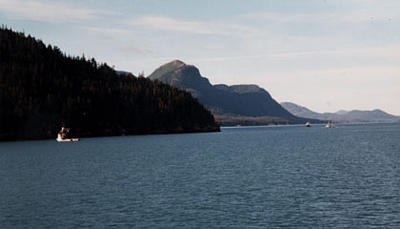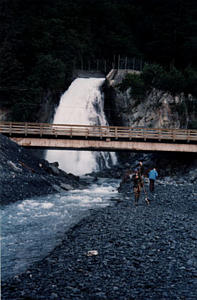
|
|
17 July, 1998
Myrtle Brijbasi
TEA/Alaska - 98
Journal Entry 8 - July 17, 1998
Alaska SeaLife Center, Ak
Good morning from Seward on this cloudy and foggy day. Even these
conditions present their own beauty as the thick, puffy, white clouds drift
past the mountain sides, completely blocking them out of view. Sunshine is
promised later in the day, so we will not forget that the mountains are
still there. Besides the routing cleaning and feeding sessions, I attended
a very informative slide presentation-seminar on sea otters presented by
Dr. Terry Williams (the physiologist who will be involved with the river
otter project). Occasionally, the SeaLife Center features a visiting
Scientist on his or her research-current or past, or involvement with the
rescue, emergency care and rehabilitation of sea life. Dr. Williams spoke
about her involvement in the rescue, emergency care, rehabilitation and
population study of sea otters in the Prince William Sound area after the
Exxon Valdez Oil Spill. She also documented how this catastrophe has
interfered with the physiology of the animals and their population
dynamics. The following facts were emphatically stated:
- Hydrocarbons from the oil are absorbed directly into the skin and cause
liver and kidney damage, and blood disorders.
- Severely oiled sea otters showed liver disorders, kidney failure, and
blood disorders. Many sea otters died even with the best emergency care,
because the insulating air-layer of their fur became non-functional and
they suffered from hypothermia. In addition they were too weak for
continuous grooming, since their poor nutritional reserves could not supply
the energy required for normal constant grooming and to generate body heat.
- Sea Otters also ingested oiled food, and that too affected their physiology.
- They died at alarming rates and were placed on the endangered list.
However, the population is on the up-swing and sea otters are no longer
considered endangered in Alaska.
It was an excellent learning experience about arctic mammals.
During the afternoon, we continued with observations and recorded
same. We also visited the travelling Pratt Museum exhibit entitled
"Darkened Waters - Profile of an Oil Spill". The exhibits were very graphic
and disturbing especially the extensive damage of animal life and the
environment, and the disruption of the Native Alaskan culture. It made me
very angry to hear the recorded slurred speech and delayed responses of the
Captain of the Exxon Valdez at the time of the spill, and the slow reaction
to the clean up efforts even though volunteers and tasks forces were in
place. Had there been quicker responses, the extent of the damage could
have been minimized. All of this is now hindsight. One thing that is for
sure, Exxon has learned its lesson, and has implemented a number of
precautionary measures so as not to experience such a disaster again. They
are also committed to protecting the environment, and the SeaLife Center is
one of their commitments to protecting the animals of Alaska.
My day ended on a very pleasant note. I visited the Chugach
Heritage Center for a cultural presentation on Alaskan Native legends. It
was an excellent show and I learned quite a bit. The costumes for each of
the scenes were very elaborate. On my way home I walked along the shore
collecting kelp that washed up. I was also fortunate to see a raven up
close, and a sea lion swimming in the bay. Both animals were unconcerned
about on-lookers. The sea lion was moving very gracefully in the water.
Here ends another day. See you tomorrow and then I will share some otter
facts with you. Bye, Bye!!

Prince William Sound nine years after the Exxon Valdez oil spill.

Waterfall just up the coast from the SeaLife center where many people come to fish.
Contact the TEA in the field at
.
If you cannot connect through your browser, copy the
TEA's e-mail address in the "To:" line of
your favorite e-mail package.
|
